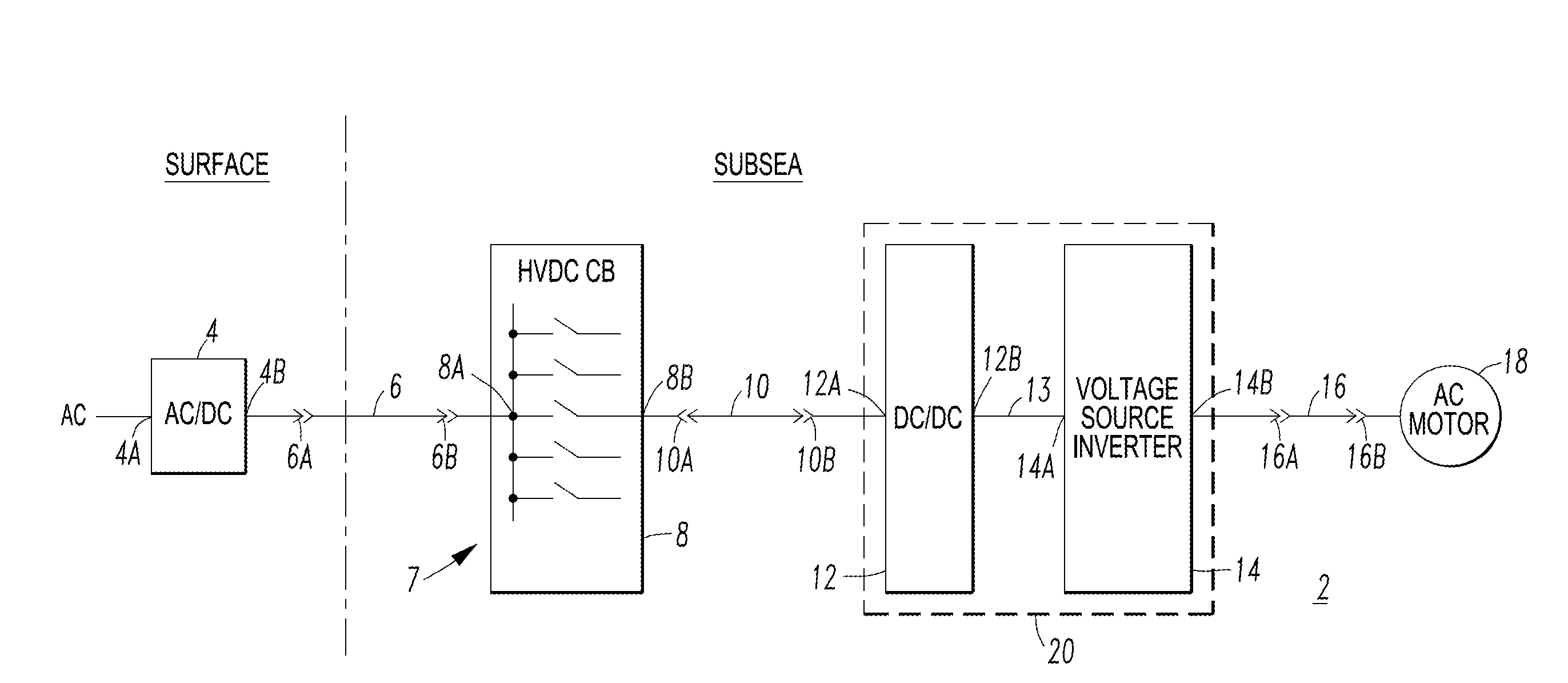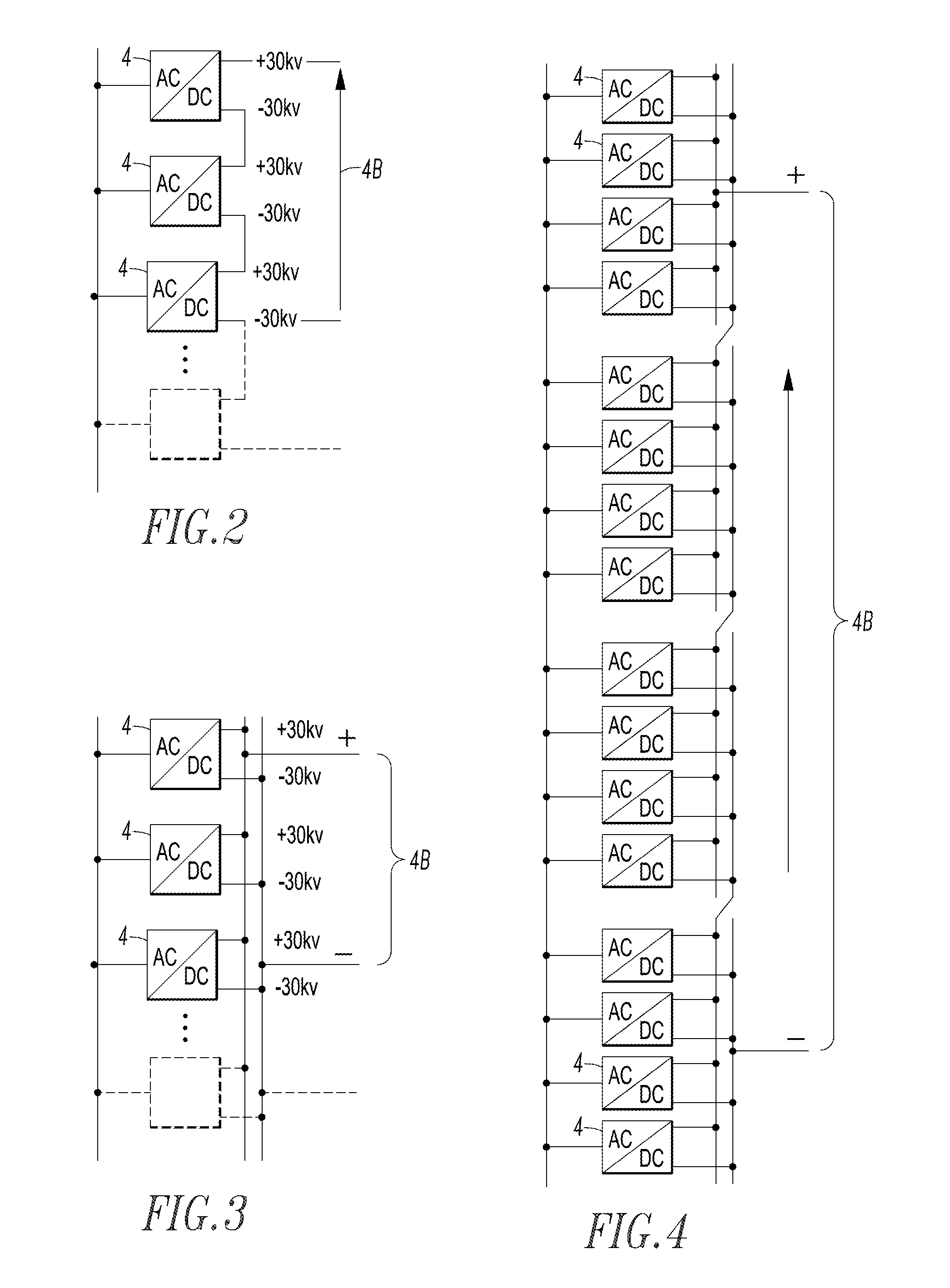High voltage direct current transmission and distribution system
a direct current transmission and distribution system technology, applied in the field of power distribution, can solve the problems of excessive losses, large voltage spikes along the cable length, and compromise the insulation of the cable itself as well as the insulation
- Summary
- Abstract
- Description
- Claims
- Application Information
AI Technical Summary
Benefits of technology
Problems solved by technology
Method used
Image
Examples
example 1
[0036]The AC / DC converter 4 can be installed on or above the surface of the sea or underwater (e.g., subsea) and is structured to ramp the DC voltage of the DC output 4B at a limited rate in order to avoid high voltage transients in the transmission line of the HVDC cable 6 during its energization. In the case of underwater installation, there is an isolation transformer (not shown) on a platform (not shown) and a multi-pulse transformer and converter (not shown) underwater. This configuration minimizes the ground current at the source.
[0037]The HVDC circuit breaker 8, the HVDC cable 10, the galvanically isolated DC / DC converter 12, the DC / AC voltage source inverter 14, the enclosure 20, the AC transmission line 16, and the AC load 18 are either subsea or below ground.
[0038]As a non-limiting example, the typical output voltage of the AC / DC converter 4 is + / −5 kV to + / −30 kV and the AC / DC converter 4 can be connected in series (FIG. 2), in parallel (FIG. 3) or in series and in parall...
example 2
[0041]The HVDC cable 6 employs bipolar transmission, and can be partially above ground and partially below ground, partially above sea and partially subsea, entirely subsea, or entirely below ground. For example, FIG. 5 shows another system 2′ in which the HVDC cable 6′ is partially above sea and partially subsea. No unipolar transmission is allowed in subsea or below ground applications due to galvanic corrosion of components of the enclosures involved.
example 3
[0042]The HVDC circuit breaker 8 includes a cable pre-charge function to prevent high voltage transients in the transmission line of the HVDC cable 10. The HVDC circuit breaker 8 protects a number of branch circuits (e.g., FIG. 5 shows a plurality of branch circuits of plural HVDC cables 10) derived off of the main HVDC transmission line of HVDC cable 6′, and pulse width modulates the output 8B to charge the downstream load side transmission line of the HVDC cable 10 to prevent high voltage transients due to cable length. A fault current generated due to a short circuit in the transmission line of the HVDC cable 10 or the input 12A of the galvanically isolated DC / DC buck converter 12 will be contained and isolated by the HVDC circuit breaker 8. As a result, the DC circuit breaker solid-state switches (e.g., 26 of FIG. 16) are turned off to protect the downstream power circuit from excessive energy.
[0043]The transmission line of the HVDC cable 10 contains resistive 10R, inductive 10L...
PUM
 Login to View More
Login to View More Abstract
Description
Claims
Application Information
 Login to View More
Login to View More - R&D
- Intellectual Property
- Life Sciences
- Materials
- Tech Scout
- Unparalleled Data Quality
- Higher Quality Content
- 60% Fewer Hallucinations
Browse by: Latest US Patents, China's latest patents, Technical Efficacy Thesaurus, Application Domain, Technology Topic, Popular Technical Reports.
© 2025 PatSnap. All rights reserved.Legal|Privacy policy|Modern Slavery Act Transparency Statement|Sitemap|About US| Contact US: help@patsnap.com



